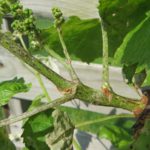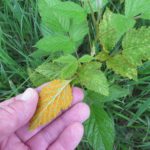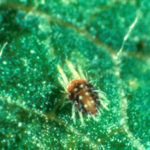The weather the past 3 weeks has been ideal for development of Phomopsis cane and leaf spot. Temperatures have been cool with frequent rain, and shoot growth has been slow. These conditions favor sporulation and infection by Phomopsis viticola. This pathogen is one of the major causes of fruit rot in the Midwest. Early season[Read More…]
Disease Management
The recent spate of cool, wet weather has left one organism happy, Venturia inaequalis, the fungus that causes apple scab. Most of the state just underwent an extreme scab period, and unfortunately, few of us could do anything about it because of the combination of rain and wind. The revised Mill’s table (from http://www.fruit.cornell.edu/tfabp/revmills.htm )identifies[Read More…]
Upticks in powdery mildew last year, plus a mild winter (which allows the fungus to overwinter in buds) set the stage for powdery mildew (Fig.3). Early season rains kept things at bay, but the recent change to drier weather while leaves continue to grow sets the stage for this disease. Powdery mildew is active during[Read More…]
Grape growth is a bit ahead of normal this year. Grapes are at the critical early shoot growth stage when Phomopsis cane and leaf spot infections occur. This is a critical time to take preventative control measures for this disease. If left unchecked, the early shoot infections will spread to cluster stems and developing berries.[Read More…]
Orange rust is one of the most common diseases of blackberries and black raspberries in the Midwest. It is a systemic disease that is confined to Rubus spp. (autoecious). There are two forms, a long-cycle form that occurs on black raspberry, and a short-cycle form that occurs on blackberries. There are two causal organisms: Arthuriomyces[Read More…]
Uneven bud break is affecting some of the apple varieties at Meigs (Fig. 1). This is usually associated with apples that grow in areas with mild winters, like the one we just had. Apple trees in warmer climates often demonstrate uneven bud breaking and bloom times. With some trees exhibiting everything from silver tip to[Read More…]
The 2017 growing season has officially started as vines are budding out. As we go through the next couple of weeks, it is important to realize that some potential pest and disease problems require early season sprays. The first is Phomopsis, a major problem on many grape varieties in the Midwest. Mancozeb should be applied[Read More…]
As the spray season approaches, it is good to remember the profound impact water quality has on the performance of pesticides used by fruit growers. Purdue Pesticides Program recently published a guide, The Impact of Water Quality on Pesticide Performance PPP-86, available at the Education Store, 1-888-EXT-INFO or www.extension.purdue.edu/store/. I highly recommend this guide to[Read More…]
Managing Mites in a BMSB World For several decades, apple growers in Indiana and elsewhere in the Midwest have used a highly effective system to manage European red mites that is based on conservation of the predatory mite, Amblyseius fallacis, along with timely applications of either preventive or rescue miticides. The rationale behind this approach[Read More…]








